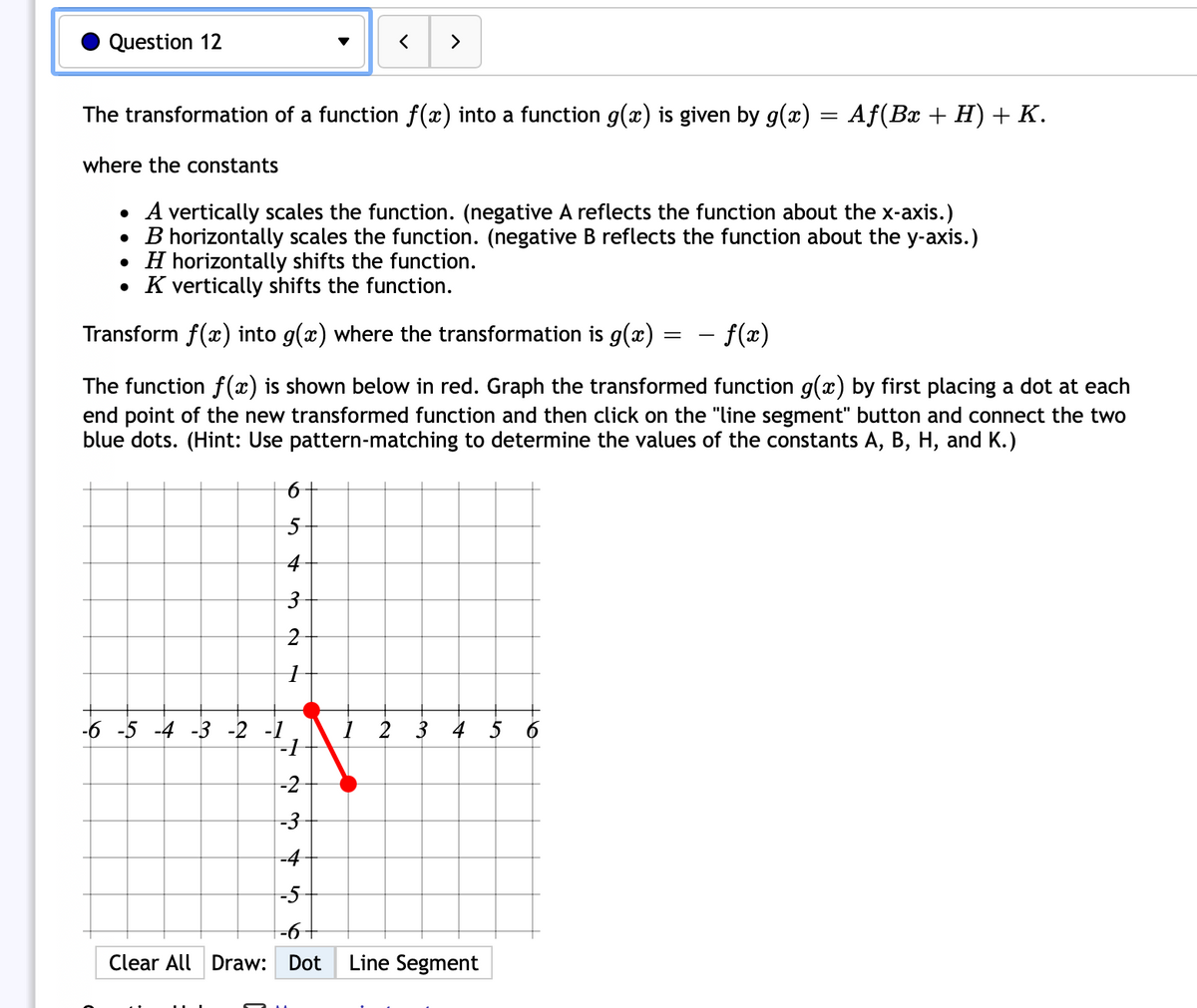Question 12 > The transformation of a function f(x) into a function g(x) is given by g(x) = Af(Bx + H) + K. where the constants • A vertically scales the function. (negative A reflects the function about the x-axis.) B horizontally scales the function. (negative B reflects the function about the y-axis.) • H horizontally shifts the function. K vertically shifts the function. Transform f(x) into g(x) where the transformation is g(x) - f(x) The function f (x) is shown below in red. Graph the transformed function g(x) by first placing a dot at each end point of the new transformed function and then click on the "line segment" button and connect the two blue dots. (Hint: Use pattern-matching to determine the values of the constants A, B, H, and K.) 6+ 5- 4 3- -6 -5 -4 -3 -2 -1 -1 I 2 3 4 5 6 -2 -3 -4 -5 -6+ Clear All Draw: Dot Line Segment
Question 12 > The transformation of a function f(x) into a function g(x) is given by g(x) = Af(Bx + H) + K. where the constants • A vertically scales the function. (negative A reflects the function about the x-axis.) B horizontally scales the function. (negative B reflects the function about the y-axis.) • H horizontally shifts the function. K vertically shifts the function. Transform f(x) into g(x) where the transformation is g(x) - f(x) The function f (x) is shown below in red. Graph the transformed function g(x) by first placing a dot at each end point of the new transformed function and then click on the "line segment" button and connect the two blue dots. (Hint: Use pattern-matching to determine the values of the constants A, B, H, and K.) 6+ 5- 4 3- -6 -5 -4 -3 -2 -1 -1 I 2 3 4 5 6 -2 -3 -4 -5 -6+ Clear All Draw: Dot Line Segment
Algebra & Trigonometry with Analytic Geometry
13th Edition
ISBN:9781133382119
Author:Swokowski
Publisher:Swokowski
Chapter5: Inverse, Exponential, And Logarithmic Functions
Section5.2: Exponential Functions
Problem 31E
Related questions
Question
100%

Transcribed Image Text:Question 12
>
The transformation of a function f(x) into a function g(x) is given by g(x) = Af(Bx + H) + K.
where the constants
A vertically scales the function. (negative A reflects the function about the x-axis.)
• B horizontally scales the function. (negative B reflects the function about the y-axis.)
• H horizontally shifts the function.
K vertically shifts the function.
Transform f(x) into g(x) where the transformation is g(x) = – f (x)
The function f (x) is shown below in red. Graph the transformed function g(æ) by first placing a dot at each
end point of the new transformed function and then click on the "line segment" button and connect the two
blue dots. (Hint: Use pattern-matching to determine the values of the constants A, B, H, and K.)
6+
5
2
-6 -5 -4 -3 -2 -1
-1
1 2 3 4 5 6
-2
-3
-4
-5
-6-
Clear All Draw: Dot
Line Segment
3.
Expert Solution
This question has been solved!
Explore an expertly crafted, step-by-step solution for a thorough understanding of key concepts.
Step by step
Solved in 2 steps with 1 images

Recommended textbooks for you

Algebra & Trigonometry with Analytic Geometry
Algebra
ISBN:
9781133382119
Author:
Swokowski
Publisher:
Cengage

Algebra & Trigonometry with Analytic Geometry
Algebra
ISBN:
9781133382119
Author:
Swokowski
Publisher:
Cengage